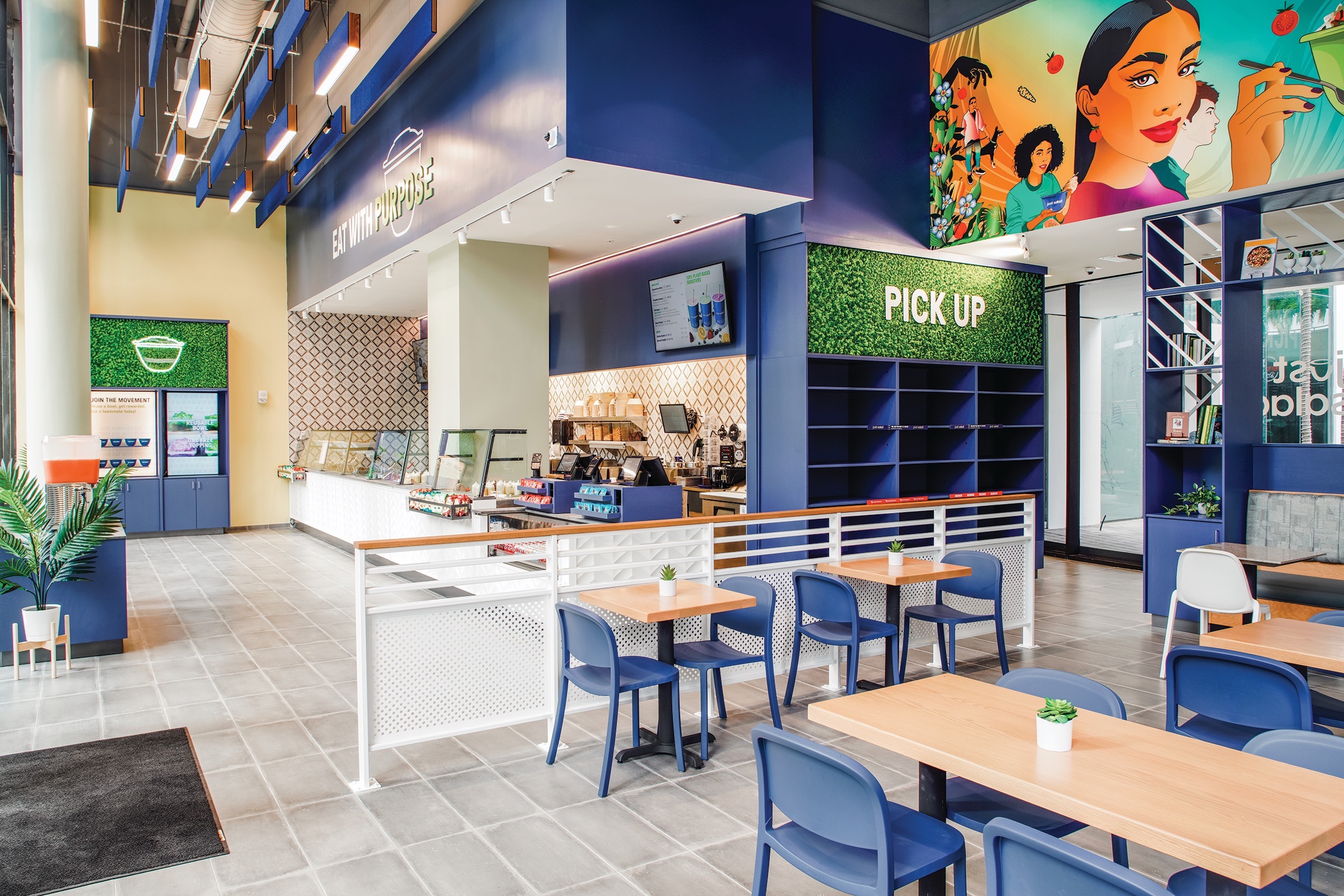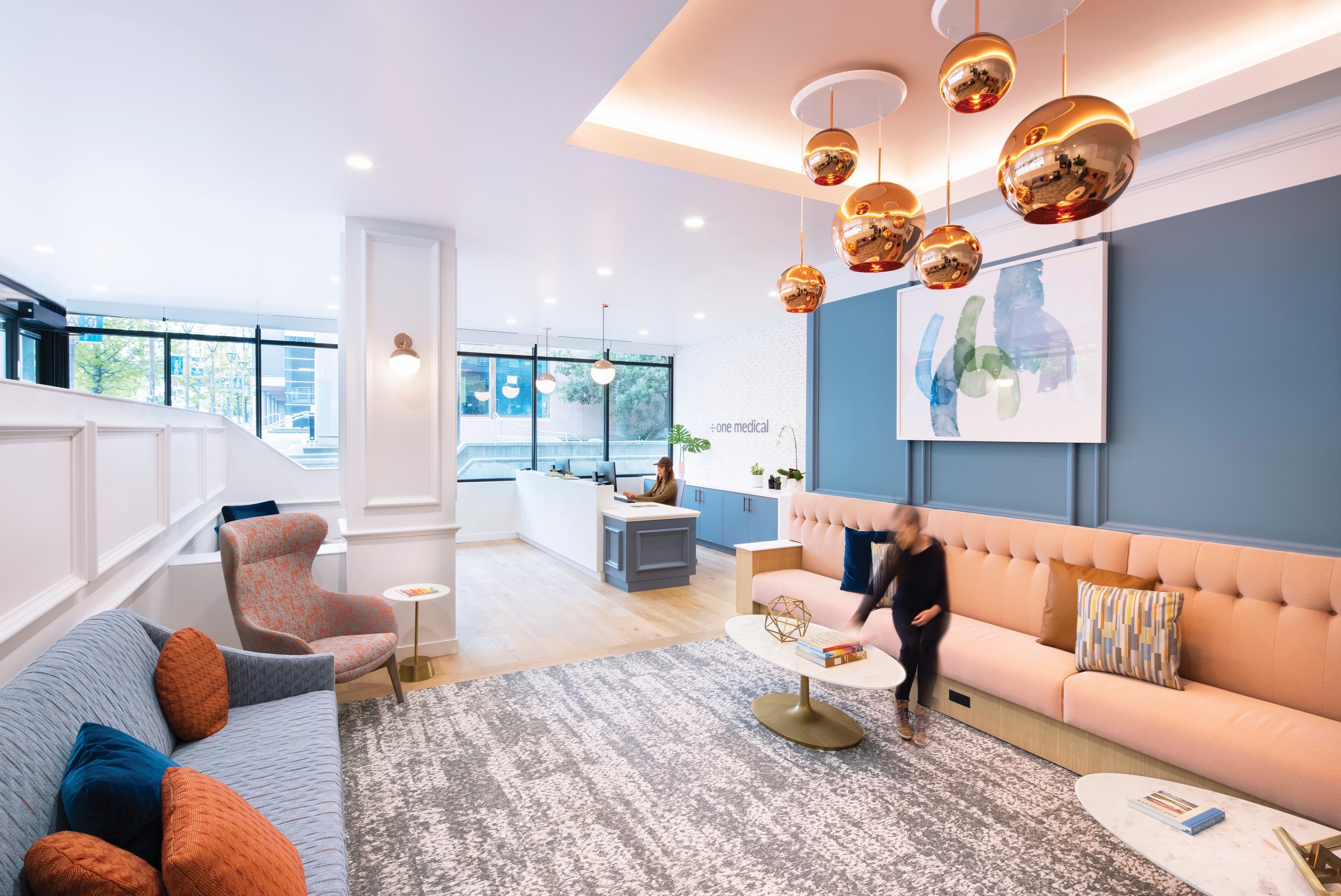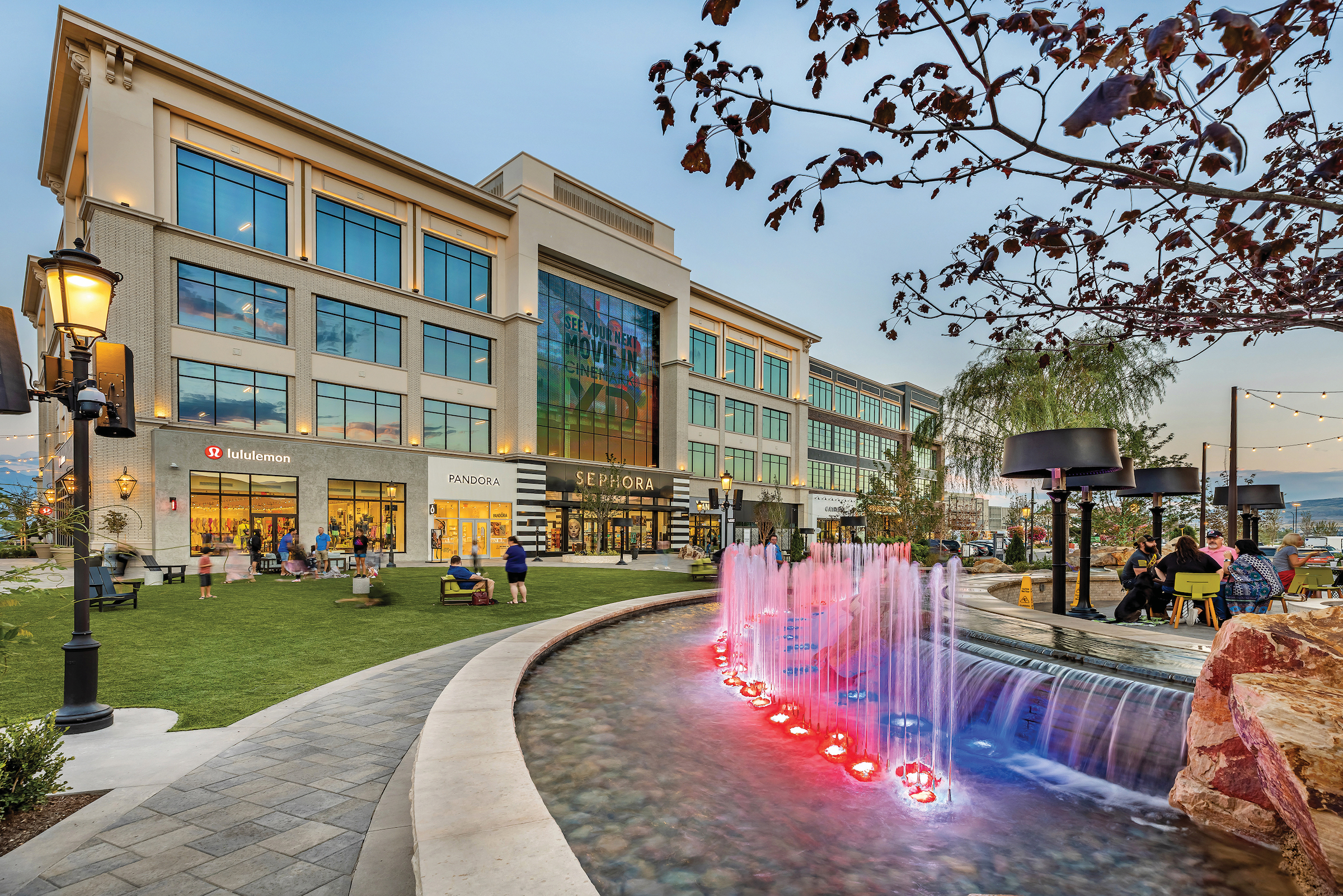Over the past year or so, California-based AO has enjoyed a bump in its retail design assignments that, according to its Managing Partner Rob Budetti, can be attributed mostly to retail being integrated into larger mixed-use projects—one of the leading retail design trends today.
“The mixed-use trend is expanding to more non-traditional elements, incorporating industrial, retail, entertainment, residential into one cohesive development,” he explains. One such example in AO’s portfolio is Phase II of Mountain View Village in South Valley, Utah. AO designed the master plan for this 85-acre destination with more than one million sf of constructed space that includes 30 dining options, a 14-screen Cinemark Theater complex, 177,000 square feet of Class A offices, and shopping options for health and beauty, apparel, home furnishings, and electronics.
The landscaping of Mountain View Village, whose construction was completed in 2022, features thousands of plants and 1,700 new trees. “Our goal was to design and plan a retail concept that replicated a downtown feel with a sense that the buildings were developed over time,” says Budetti.
Retail has also been one of Kimley-Horn’s fastest-growing practice sectors, increasing nearly 80% in 2022, according to Lesley Netzer, the firm’s Director of Retail. Mixed use drove that growth, as traditional shopping malls “are turning into communities offering a combination of apartments, gyms, grocery stores, theaters, retailers, offices, and restaurants.” One of Kimley-Horn’s recent projects, for which it provided civil engineering, due diligence, and permitting services, was The Yard at Fischers District in Indiana, a mixed-use development with multiple restaurants and retail within close proximity. To the east of Fischers District, which was completed last year, Kimley-Horn continues to work on a development called The Stations, which will include a retail pad, a hotel, an office building pad, and 37 townhouses.
Adjusting to seismic disruptions in the retail sector
Retail was as hard hit by the coronavirus pandemic as any corner of the U.S. economy. Simultaneously, retailing was being rattled by the tectonic shift to where online shopping and ordering predominate. These factors alone have made the sector harder to read, even as most of the AEC Giants contacted for this article say their retail practices have been thriving lately.
“On the occupier side of retail, our work has slightly decreased. Our clients are being cautious due to the economy,” says Greg Lang, CBRE’s Senior Managing Director–Retail and Multi-Site sector. However, he adds, his firm has seen an uptick in demand among its investor clients for tenant coordination and real estate development services “for the first time in 2-3 years.”
(Investors and developers continue to send out mixed signals about their interest in retail properties. A few weeks after BD+C interviewed Lang, Pacific Retail Capital Partners acquired the 1.2 million-sf Bridgewater Commons shopping mall in New Jersey, with more than 150 retail tenants. The acquisition included an adjacent 94,000-sf open-air shopping district called The Village at Bridgewater Commons. On the other hand, David Simon, CEO of the mall giant Simon Property Group, told WWD last February that his company wasn’t planning on buying more retailers, at least in the near term.)

Jonathan Fiato, Shawmut Design and Construction’s Senior Director–New York Region, says his firm has also seen an increase in retail-related construction demand, especially among retailers and brands that are investing in their flagship locations. He cites BMW Mini’s Manhattan flagship as one prominent example, as well as Culture Kings’ U.S. flagship, a two-story, 25,000-sf store that opened last November in The Forum Shops at Caesars in Las Vegas. This is Culture Kings’ largest store to date, and features a 75-foot-tall hat wall, arcade machines for patrons, a basketball half court, and a slushy bar. The building team on this project included Henderson Engineers, bokor architecture + interiors, Bunnyfish Studio, and Lighting Design Alliance.
It goes without saying that survival now requires retailers to have a strong and palpable online presence, which includes their physical stores being able to accommodate BOPIS, which stands for “buy online pick up in store.” “Systems need to connect seamlessly to online ordering, inventory, etc., and be easily managed by instore associates,” asserts Michele Devereaux, CPSM, Marketing Strategist for the retail mixed-use practice of Callison RTKL, a division of Arcadis.
While AEC firms report less downsizing of bricks and mortar stores than might be expected, they have been seeing more retailers reducing their in-store inventories in favor of spacious showroom presentations. Retailers “are trending toward right sizing that enhances the omnichannel retail experience,” says Shawn Bland, Core States Group’s Director of Retail. This trend, he adds, has been a boon for his firm’s in-house architectural, engineering, and program management services to help retail clients devise branded, unique brick-and-mortar environments. (Bland points specifically to his firm’s recent work for Primark in Sunrise, Fla., Just Salad in Miami, and the Lidl grocery in Exton, Pa.)
Opportunities for reinvention of retail design
Jason Zoeller, Retail Sector Executive for Henderson Engineers, says that retail clients should always be thinking ahead about how their spaces might need to evolve in the future. He says he’s already seeing a shift toward flexibility about store locations at a time when there’s broad availability of retail space that’s cost effective and offers greater return on investment.
This flexibility is creating opportunities for renovation and adaptive reuse. “We continue to push innovation and develop creative design solutions for clients seeking flexible spaces which can contract and expand based on tenant needs,” says AO’s Budetti.
Lounges in banks and car dealerships are signs of this trend. Other examples find Kimley-Horn helping a nationwide general merchandise retailer upgrade its MEP systems and secure permitting to move refrigeration to the front of its stores. Netzer adds that shopping center developers are collaborating with AEC firms to design interior spaces that appeal to multiple generations, and are ordering landscape architecture for exterior spaces of national restaurants.

To accommodate customers who prefer to order online from their smartphones or cars, quick-service restaurants are building more drive-thrus or mobile-only smaller buildings. (Netzer notes, parenthetically, that these retailers still have the same land needs because the pickup spaces must be larger.)
Retailers are turning to AEC firms when they need to reposition their image with consumers. For example, CallisonRTKL recently helped Petco transform its brand from a big-box pet products store to a health-and-wellness service for pets and their owners. The redesign entailed wider aisles and streamlined wayfinding to make the store easier to navigate. The service design focuses on quality and convenience, and supports every in-store interaction.
Non-retail tenants welcomed
AEC firms say that retail developers and property owner/managers have become more receptive to leasing space to non-retail tenants in shopping plazas and strip malls.
“What’s changed,” explains AO’s Budetti, “is the integration of expanded asset types like multifamily, medical, hospitality, coworking, fulfillment, and larger entertainment venues.” As part of the so-called “Medtail” trend, CallisonRTKL has been assisting One Medical Group, a concierge medical practice, to reposition its spaces as calming, comfortable environments. Since 2017, the firm has provided architectural design and construction administration services for more than a dozen of One Medical Group’s locations that range from 3,000 to 6,000 sf, many of them within retail centers, says Devereaux.
Non-retail tenants sometimes have design and engineering requirements that are different from basic clothing or jewelry stores. “Ventilation, finish treatments, wall assemblies, and lighting are all considerations,” says Devereaux.
AO, says Budetti, has found that upgrades to existing structures are often required to handle larger live loads. Making changes might also mean that zoning needs to be renegotiated. Lang of CBRE says that plumbing is “a major challenge” when converting retail space for non-retail use, especially in older enclosed malls whose infrastructure “never contemplated fitness, education, or medical/dental tenants.” Lang adds that electrical systems in open-air centers typically need upgrades and more capacity. Bland of Core States Group notes as well that accommodating non-retail tenants usually means an increased need for low-voltage design services for technology such as frictionless checkout, POS ordering, and lighting and security controls.
Zoeller of Henderson Engineers suggests that having the right design and construction partners to evaluate a space before leasing is crucial, and often helps when negotiating better leasing terms depending on the upgrades needed.
Related Stories
| Aug 11, 2010
Callison, MulvannyG2 among nation's largest retail design firms, according to BD+C's Giants 300 report
A ranking of the Top 75 Retail Design Firms based on Building Design+Construction's 2009 Giants 300 survey. For more Giants 300 rankings, visit http://www.BDCnetwork.com/Giants
| Aug 11, 2010
Former nightclub morphing into a shopping center
New York City's Limelight, the one-time notorious church-turned-nightclub, will be restored again, this time as a 25,000-sf retail marketplace. Limelight Marketplace founder Jack Menashe hopes to merge lavish atmospheric elements with cutting-edge fashion, beauty, and gourmet retailers like BookSmart, Caswell Massy, J.
| Aug 11, 2010
And the world's tallest building is…
At more than 2,600 feet high, the Burj Dubai (right) can still lay claim to the title of world's tallest building—although like all other super-tall buildings, its exact height will have to be recalculated now that the Council on Tall Buildings and Urban Habitat (CTBUH) announced a change to its height criteria.
| Aug 11, 2010
New pavilion planned for famous boulevard
Located in a prime spot along Santa Monica Boulevard in the Westwood neighborhood of Los Angeles, the Santa Monica Pavilion will have 9,000 sf of retail space, 35,500 sf of office space, and two below-grade parking levels when it opens in late 2010. The $10 million, three-story building extends a full length of the block to create a window wall of blue-gray translucent, fritted glass panels ove...
| Aug 11, 2010
Mixed-use Seattle high-rise earns LEED Gold
Seattle’s 2201 Westlake development became the city’s first mixed-use and high-rise residential project to earn LEED Gold. Located in Seattle’s South Lake Union neighborhood, the newly completed 450,000-sf complex includes 300,000 sf of Class A office space, 135 luxury condominiums (known as Enso), and 25,000 sf of retail space.
| Aug 11, 2010
Expanding retail complex is LEED pre-certified
The Promenade at Coconut Creek in Broward County, Fla., a live-work-play shopping and lifestyle center, is being expanded by 105,000 sf. When phase II of the 335,000-sf project is complete, the facility will house 75 retailers, restaurants, and related services, making it one of the largest mixed-use projects in northern Broward County.
| Aug 11, 2010
CityCenter projects get LEED Gold
MGM Mirage and Infinity World Development have received LEED Gold certification for the first three CityCenter projects: the ARIA Resort hotel tower, ARIA Resort convention center and theater, and the Vdara Hotel (above). The CityCenter developers anticipate Gold or Silver LEED certification for the project's remaining developments, which include a Mandarin Oriental hotel, a 500,000-sf retail a...
| Aug 11, 2010
RMJM unveils design details for $1B green development in Turkey
RMJM has unveiled the design for the $1 billion Varyap Meridian development it is master planning in Istanbul, Turkey's Atasehir district, a new residential and business district. Set on a highly visible site that features panoramic views stretching from the Bosporus Strait in the west to the Sea of Marmara to the south, the 372,000-square-meter development includes a 60-story tower, 1,500 resi...
| Aug 11, 2010
'Feebate' program to reward green buildings in Portland, Ore.
Officials in Portland, Ore., have proposed a green building incentive program that would be the first of its kind in the U.S. Under the program, new commercial buildings, 20,000 sf or larger, that meet Oregon's state building code would be assessed a fee by the city of up to $3.46/sf. The fee would be waived for buildings that achieve LEED Silver certification from the U.







